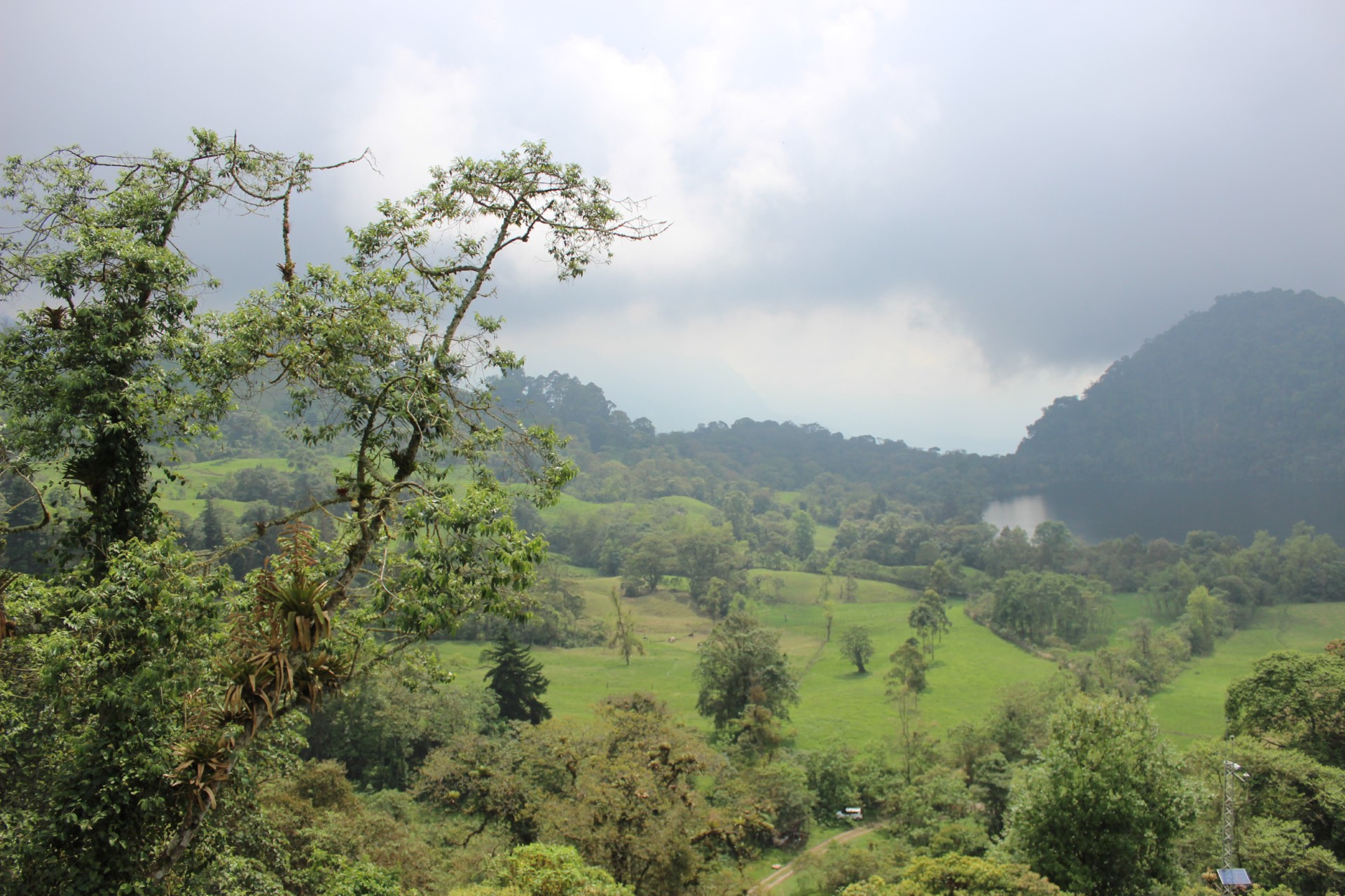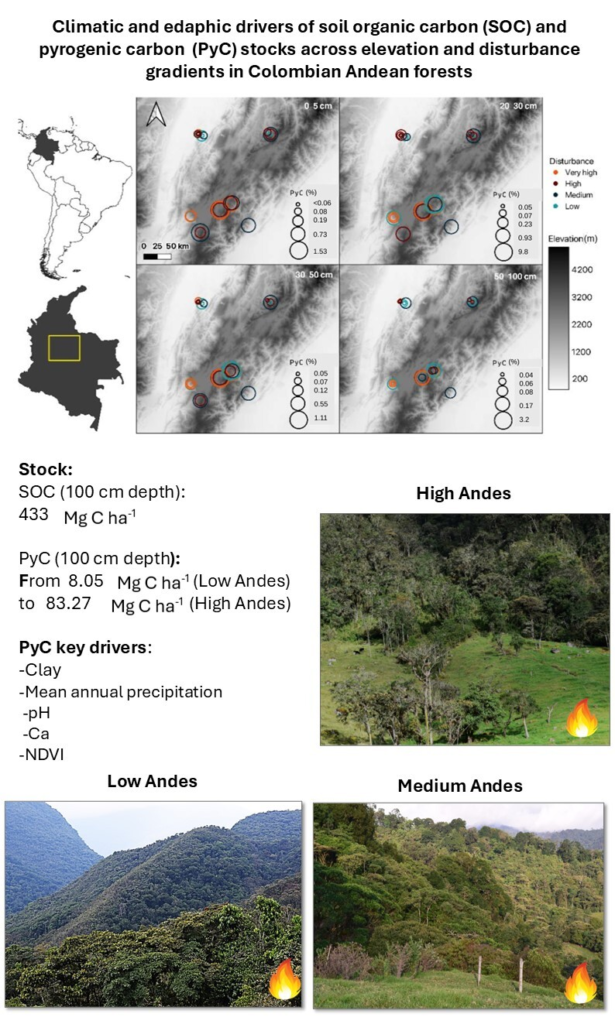
Posted by Ted Feldpausch
28 July 2025The soil in high-elevation, cooler, drier tropical forests in the Colombian Andes stores more carbon from fires than lower, warmer regions, new research shows.
We investigated the long-term impact of fire on Andean forest soils, finding that carbon from fires – known as pyrogenic carbon (PyC) – varies greatly across Colombia’s lowlands and Andean mountains.
The team, under the Colombia BioResilience project, analysed soil samples from 36 plots across different elevations and land-use types, including lowland, mid-elevation, and High Andean forests.
We found that – while overall soil organic carbon (SOC) is substantial in Andean forests – High Andean forests had PyC stocks nine to ten times higher than those in the warmer, low Andean forests and the Amazon Basin rainforest.

The study was led by Dr Carmen R. Montes-Pulido from Universidad Nacional Abierta y a Distancia, Professor Ted Feldpausch from the University of Exeter, and colleagues from James Cook University and Instituto Nacional de Pesquisas da Amazônia.
Professor Feldpausch said: “Our study highlights the long-term legacy effects of wildfires on Andean forest soils. These are the first data of this type for the northern Andes and the substantially larger fire-derived soil carbon found in the high Andean forests represents an important persistent carbon reservoir. The results raise questions about how historical land-use over hundreds to thousands of years may have interacted with variation in climate and fire regimes to alter fire-derived soil carbon.”
The research found that mean annual precipitation, soil clay content, and pH were the primary environmental factors related to soil PyC storage. These factors influence the formation and preservation of PyC in the soil, highlighting the interaction between climate, soil chemistry, and fire history in shaping carbon stocks.
Dr Carmen R. Montes-Pulido said: “The findings highlight the larger-than-expected contribution of PyC to the total carbon pool in Andean forest soils and its importance as a stable and persistent form of carbon, particularly under projected global warming scenarios.”

These research findings are essential for improving our understanding of carbon cycling in tropical mountain ecosystems and refining global carbon models, since PyC is much slower to decompose—over hundreds to thousands of years—than other forms of soil carbon.
The study shows that PyC in Andean forest soils, especially at cooler, drier high elevations, is not only a significant carbon reservoir but also a key component in the long-term carbon storage capacity of these biodiverse, vulnerable ecosystems.
As climate change increases temperatures, understanding the dynamics of PyC in these elevation gradients becomes increasingly important for conservation and climate mitigation strategies.
The research project – “BioResilience: Biodiversity resilience and ecosystem services in post-conflict socio-ecological systems in Colombia” – was supported by funding from the UK Natural Environment Research Council (NERC) and the Arts and Humanities Research Council
(AHRC) under the Newton-Caldas Colombia-Bio programme (NERC, Grant NE/R017980/1). Additional support was provided by NERC project (Grant NE/N011570/1).
The paper, published in the journal Global Change Biology, is entitled: “Climatic and edaphic drivers of soil organic carbon and pyrogenic carbon stocks across elevation and disturbance gradients in Colombian Andean forests.”
Header image photo credit (Ted Feldpausch): Mid elevation forests and pastures near the study sites in the Colombian Andes
Comprender los factores que impulsan la variación del carbono orgánico del suelo (COS) y del carbono pirogénico del suelo (PyC) y su papel en los ecosistemas naturales y gestionados, es cada vez mas importante. Sin embargo, las reservas de PyC en los suelos andinos tropicales siguen estando poco estudiadas. Este estudio evaluó cómo los factores edáficos y ambientales afectan el PyC a través de diferentes gradientes de elevación y perturbación en 36 parcelas que abarcan bosques naturales y sistemas agrosilvopastoriles en los Andes colombianos. En el perfil de suelo de 0–100 cm, el stock medio de COS en la region estudiada fue de 433.10 Mg C ha−1 (rango:67.97–1462 Mg C ha−1) mientras que la existencia media de PyC fue de 34.13 Mg C ha−1 (rango: 2.29–305.70 Mg C ha−1) lo que representa aproximadamente el ~8% del COS total. Esta reserva de PyC es aproximadamente nueve veces mayor que la media de toda la Amazonía. El PyC (%) no varió significativamente con los gradientes de perturbación o la profundidad del suelo. Sin embargo, tanto el PyC (%) como el COS (%) variaron significativamente con la zonificación altitudinal (p < 0.001). Los Altos Andes presentaron las concentraciones más altas de PyC (1.3%) y COS(14.6%), respecto a los Andes Medios (PyC = 0.17%; COS = 6.7%) y los Andes Bajos (PyC = 0.06%; COS = 1.3%). El contenido de arcilla del suelo y la precipitación anual fueron los principales factores determinantes del PyC, explicando el 56% de la variabilidad cuando se combinaron con el pH, el Ca y el NDVI. El PyC se asoció positivamente con el contenido de arcilla (estimación: 0.27, p < 0.001) y negativamente con la precipitación anual (estimación: −0.18, p < 0.05). Estos factores pueden influir en los procesos fisicos y quimicos que afectan a la formacion y conservacion del PyC en los suelos. Este análisis proporciona información sobre la variabilidad del COS y el PyC en los suelos forestales andinos, destacando la sustancial contribucion del PyC al carbono total del suelo y su importancia como carbono persistente en las condiciones de calentamiento actuales y previstas en toda la region.